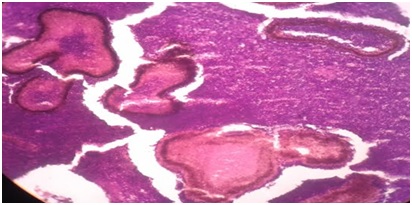Maduramycosis in forearm -A case report
Abstract
Myetoma or Maduramycosis is a chronic granulomatous infection affecting skin and subcutaneous tissue and bone. Mycetoma is caused by Actinomycetes or by fungi such as Madurellamycetomi, Madurellagriesia etc. Eumycetoma is most commonly seen in males. The common site being foot and referred as Madura foot. The organisms present in soil are presumed to be inoculated directly after skin penetration with sharp objects like thorn and gain access to skin and subcutaneous tissue. Multiple nodules develop which suppurate and discharge grains through sinuses during active phase of the disease. We hereby report a case of Twenty year old female presented with painless swelling in right forearm which was clinically diagnosed as Lipoma and biopsy proved it to be Maduramycosis.
Downloads
References
2. Magana M. Mycetoma. Int J Dermatol. 1984 May;23(4):221-36.[pubmed]
3. Lupi O, Tyring SK, McGinnis MR. et al. Tropical dermatology: fungal tropical diseases. J Am Acad Dermatol. 2005 Dec;53(6):931-51, quiz 952-4.[pubmed]
4. McGinnis MR. Mycetoma. Dermatol Clin. 1996 Jan;14(1):97-104.[pubmed]
5. Fahal AH, Suliman SH. Clinical presentation ofmycetoma. Sudan Med. J 1994; 32: 46–66.
6. Lichon V, Khachemoune A. Mycetoma: a review. Am J Clin Dermatol. 2006;7(5): 315-21.doi:10.2165/00128071-200607050-00005.[pubmed]
7. Barnetson RS, Milne LJ. Mycetoma. Br J Dermatol. 1978 Aug;99(2):227-31.[pubmed]
8. Maiti PK, Ray A, Bandyopadhyay S. Epidemiological aspects of mycetoma from a retrospective study of 264 cases in West Bengal. Trop Med Int Health. 2002 Sep;7(9):788-92.[pubmed]
9. Zaias N, Taplin D, Rebell G. Mycetoma. Arch Dermatol. 1969 Feb;99(2):215-25.[pubmed]
10. Pilsczek FH, Augenbraun M. Mycetoma fungal infection: multiple organisms as colonizers or pathogens? Rev Soc Bras Med Trop. 2007 Jul-Aug;40(4):463-5.[pubmed]
11. Taralakshmi VV, Pankajalakshmi VV, Arumugam S, Subramanian S. Mycetoma caused by Madurellamycetomii in Madras. Australas J Dermatol. 1978 Dec;19(3):125-9.[pubmed]
12. Kiran Alam, Veena Maheshwari, Shruti Bhargava. Histological Diagnosis of Madura Foot (Mycetoma): A Must for Definitive Treatment . J Glob Infect Dis. 2009 Jan-Jun; 1(1): 64–67.doi: 10.4103/0974-777X.52985. PMCID: PMC2840937.
13. Welsh O, Vera-Cabrera L, Salinas-Carmona MC. Mycetoma. Clin Dermatol. 2007 Mar-Apr;25(2):195-202.DOI:10.1016/j.clindermatol.2006.05.011.[pubmed]
14. Elmaataoui A, Elmoustachi A, Aoufi S, Lyagoubi M. Eumycetoma due to Madurellamycetomatis from two cases of black grain mycetoma in Morocco.J. Mycol. Med., 2011;21(4):281-284



 OAI - Open Archives Initiative
OAI - Open Archives Initiative


